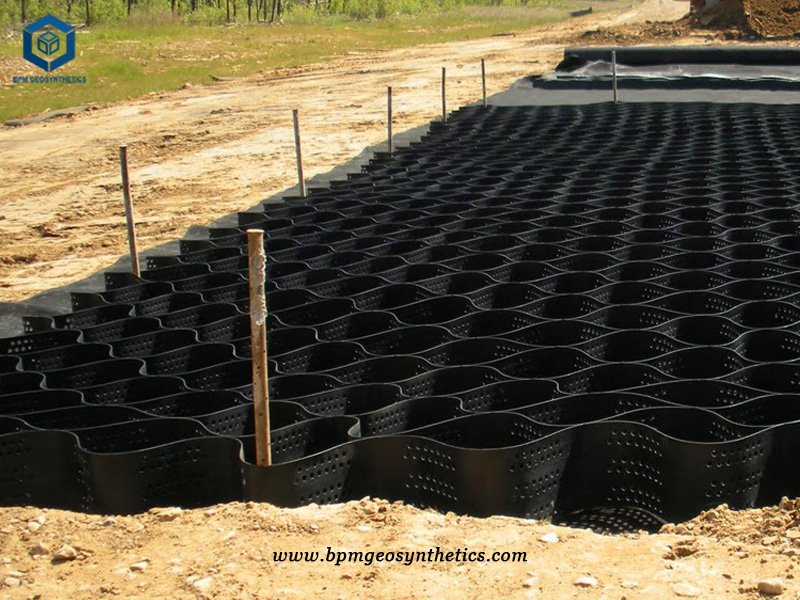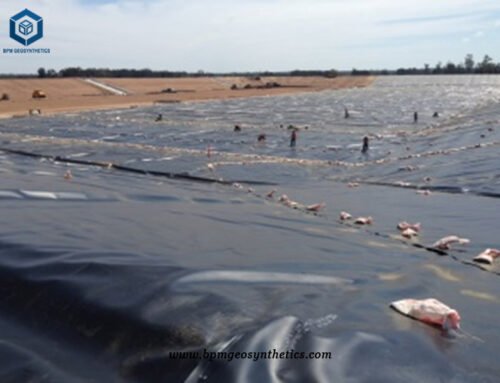Geocell HDPE Material is a unique three-dimensional mesh cell structure made from reinforced HDPE sheet material through high-strength welding, typically using ultrasonic needle welding. In some cases, holes are punched through the diaphragm for specific engineering requirements.
The three-dimensional structure of Geocell HDPE Material effectively impedes lateral movement of the infill material, increasing the overall structural strength of the system. This makes it an ideal solution for applications that require erosion protection or load support. Additionally, the cell walls of Geocell HDPE Material are perforated to allow water flow through the system, creating an improved root zone between cells for vegetated applications.
One of the benefits of concrete-filled Geocell HDPE Material is that the HDPE matrix becomes the form for the concrete, eliminating the need for wood forms or rebar and reducing overall project costs. The panels are expanded, and the concrete is poured directly into the Geocell HDPE Material, creating a strong and durable structure that is resistant to erosion and other environmental factors. Overall, Geocell HDPE Material is a versatile and effective solution for a wide range of engineering applications.
Case Study
- Location – United States
- Product(s) – Geocell HDPE Material
- Application – Roadbed of the racecourse


Issue
A customer from the United States asked us if we could use Geocell HDPE material to restore low-humidity areas in horse farms. They want to fix driveways (with gravel or fill) and horse fields (with dirt and grass on them). Tractors are heavy when moving dirt, manure, or rocks, so the material needs to be able to withstand this weight. The client also wants to plant grass in the Geocell HDPE material to improve the environment.
Solution
We informed our technical staff of the customer’s requirements, and after analyzing the situation, we recommended a Geocell HDPE material with a height of ASTM 150mm and welding distance of 450mm. The Geocell HDPE material will have drainage holes to facilitate the growth of grass seeds.
We recommended that the customer fill the gravel with a thickness of three to four centimeters, then fill the gaps with planting soil and fill the cells higher than 3-5cm. Finally, they should compact the material and sprinkle grass seeds.
Since the customer has heavy trucks on the material, we also recommended the use of geotextile and geogrid to increase the stability of the roadbed.
We presented our solution to the client, and the client showed great interest. After confirming the quantity with the customer, we calculated the door-to-door price for the customer and provided a one-stop service to deliver the product to their home.
After the customer expressed concern about our pricing, we provided them with detailed information about our raw materials, production methods, packaging, and more. We also explained our pricing structure and the long-term benefits of using our products. After discussing the matter with their partner, the customer ultimately decided to purchase from us.
Our BPM ASTM Geocell HDPE Material is produced using 100% imported raw materials, and we guarantee that our products meet ASTM quality standards. We have a professional testing room to ensure that our products are in line with customer requirements. We use pallet packaging, which is convenient for customers to unload.
Our Geocell HDPE Material offers numerous features, including the ability to expand and contract freely, fold easily for transportation, and stretch into a net shape during construction. It can be filled with loose materials such as soil, gravel, or concrete to form a structure with strong lateral restraint and high rigidity. The material is also lightweight, wear-resistant, stable in chemical properties, and resistant to light and oxygen aging, acid, and alkali. It is suitable for different soil and desert conditions.
Furthermore, our Geocell HDPE Material provides high lateral restriction and anti-slip properties, which effectively enhance the bearing capacity of the subgrade and disperse the load. We can customize the material’s height, welding distance, and other geometric dimensions to meet different engineering needs. It is also flexible and can expand and contract easily, making it easy to transport and connect, and allowing for fast construction.
Overall, we believe that our Geocell HDPE Material is a reliable and cost-effective solution for infrastructure construction, erosion control, and slope protection. We are committed to providing our customers with high-quality products and excellent customer service, and we believe that our Geocell HDPE Material offers excellent value for money.


Engineering Applications
1. Treatment of half-filled and half-dug subgrade. When building an embankment on a slope with a natural slope steeper than 1:5, steps should be dug at the base of the embankment, and the width of the steps should not be less than 1 meter. When the road is built in stages or rebuilt and widened, the junction of the old and new subgrade fill slopes should be opened. When digging steps, the width of steps on high-grade highways is generally 2 meters. Geocell HDPE Material can be laid on each step to take advantage of its side-limited reinforcement effect, which can help solve the problem of uneven subsidence.
2. Subgrade in windy and sandy areas. The subgrade in windy and sandy areas should be mainly low embankments, and the filling height should generally not be less than 0.3 meters. Due to the professional requirements for low subgrades and heavy loads in roadbed construction in windy and sandy areas, the use of Geocell HDPE Material can play a lateral role in loose filling. The limited height ensures that the subgrade has high rigidity and strength to withstand the load stress of large vehicles.
3. Reinforcement of subgrade fill at the back of the abutment. The use of Geocell HDPE Material can better achieve the purpose of abutment back reinforcement. The Geocell HDPE Material and fillers can generate sufficient friction to effectively reduce the uneven settlement between the subgrade and the structure, which can effectively alleviate the early impact damage to the bridge deck caused by “vehicle” disease.
4. Subgrade in permafrost areas. In the construction of filled subgrades in permafrost areas, the minimum filling height should be reached to prevent muddying or lowering of the upper limit of the frozen layer, resulting in excessive settlement of the embankment. The unique facade reinforcement effect of the Geocell HDPE Material and the overall confinement of the effective implementation can ensure the minimum filling height in some special sections to the greatest extent, and make the filling have high-quality strength and stiffness.
5. Loess subsidence treatment. For highways and first-class highways passing through collapsible loess and loess sections with good compressibility, or when the allowable bearing capacity of the foundation of the high embankment is lower than the combined load of vehicles and the pressure of the embankment’s own weight, the subgrade should also be adjusted according to the bearing capacity requirements. At this time, the superiority of the Geocell HDPE Material is undoubtedly revealed.
6.Saline soil and expansive soil. Highways built with saline soil and expansive soil, first-class roads, road shoulders, and slopes are all reinforced. The façade reinforcement effect of the Geocell HDPE Material is the most excellent of all reinforcement materials, and it has excellent corrosion resistance. It can fully meet the requirements of building high roads in saline soil and expansive soil.
About BPM
BPM has been specializing in delivering one stop geosynthetics products and solutions to worldwide customers since its foundation in 2007. BPM had provided many types of effective and state of the art geomembranes, geotextiles, geocells, geosynthetic clay liners (GCLs), drainage boards, geogrids to over 81 countries. Our main customers are from Australia, France, Sweden, UK, Hong Kong, Hungary, New Zealand, Poland, Mexico, Ecuador, Brazil, Pakistan, Bangladesh, Thailand, Vietnam, Malaysia, Indonesia, Singapore, Philippines, Sri Lanka, India, UAE, Saudi Arabia, Qatar, Kenya, Ghana, Ethiopia, Somalia, Nigeria, South Africa, Swaziland, Mongolia, etc.
BPM is not only manufacturing best quality geosynthetic products but also providing professional design and installation service. OEM, ODM, custom development and fabrication are also available. If you have any questions or inquiries, please fill and submit the following form, we will reply as soon as possible.





